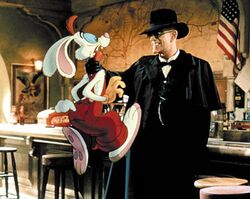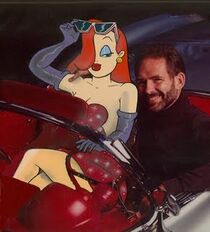Who Framed Roger Rabbit
Who Framed Roger Rabbit is a 1988 Disney live-action/animated hybrid film, directed by Robert Zemeckis with production assistance from the great Steven Spielberg. Based on a true story, the movie is an allegorical tale about the life and gruesome fall of cartoon star Roger Rabbit, when he finds himself on the 1947 Hollywood redlist. He is betrayed by his closest friends and horrifically crucified, but not before the ritualistic near-dipping of his body — a bold move for the time. The movie starred many Hollywood greats, including Bob Hoskins, Christopher Lloyd, Stubby Kaye, Joanna Cassidy, and Roger and Jessica Rabbit as themselves.
Who Framed Roger Rabbit received critical acclaim and was a blockbuster success, due to it containing more ballsy, gritty content and humor than Disney's other wishy-washy cutesy movies, and is considered to be Disney's best nostalgic film ever. It renewed interest in 1940s Golden Age animation, spearheading the '90s Disney Renaissance which includes The Little Mermaid, The Lion King, Tarzan, and all those other movies Facebook catladies love so much.
Plot[edit]
Our story takes place in 1947 in Toontown, a suburb of Hollywood, California where various classic cartoon characters live together. There, all-star Roger Rabbit (played by himself) is doing a cartoon for Maroon Cartoon Studios, and he screws up his line by having birds rather than stars around his head when he gets hurt; Roger attempts to excuse his poor show by telling the director that he was stressed-out after making thirty cartoons during World War II. Meanwhile, detective Eddie Valiant Jr. (Bob Hoskins) is investigating the then-current communist scare in Hollywood. He solved the conflict on Charlie Chaplin and now many people speculate that Roger is a communist for supporting Chaplin. After these rumors broke, Jessica Rabbit (herself) decided to have an affair with Marvin Acme (Stubby Kaye) and made sure that no one knew about it. Valiant hates working with toons since one killed his brother Teddie in 1944, but cooperates with Roger for the sake of the investigation. When he shows Roger pictures of Jessica playing patty-cake with Acme, Roger goes ballistic and realizes that Jessica was cheating on him while he was off making cartoons during the war.
The next day, Acme is found dead at Maroon Studios, and Judge Doom (Christopher Lloyd) comes in and sees that the studio is owned by a communist. Doom has created "dip", a substance capable of killing not only toons, but communists as well, and is searching for Roger Rabbit, who Doom suspects killed Acme in anger over Jessica's cheating, so he can dip him. Meanwhile, Roger hides in a bar with Acme's will (which is actually a love-letter), and Baby Herman (Lou Hirsch), a 50-year-old man with growth and bowel problems, tells Eddie that Acme's will is missing. Judge Doom, who wants to turn Toontown into Suburbia with a freeway in the middle, accuses the toons of being communist since they live in a Utopia called Toontown; Eddie then accuses Doom that he's the communist since he wants a suburban Utopia. While Eddie investigates Toontown and stops drinking booze, Roger gets knocked-down with a frying pan by Jessica. Eddie sees that Toontown is NOT communist and tells Judge Doom that he should stop accusing everyone of being communists.
Seeing that his car was stolen by Roger, Eddie calls Benny the Cab (played by Rochester) to take him and Jessica back to Acme Studios, where Judge Doom shoots R.K. Maroon (Alan Tilvern) in front of Roger. He then crucifies Roger on a cross and has Jessica see him dangle over a vat of dip, but Eddie does a comic song in blackface and kills Doom's weasels who then take a trip to hell. When Doom sees what Eddie did to his weasels, he chases him across the studio, but Eddie crushes Doom with a steamroller. Cartoonish eyes bulge out of the Judge's sockets and his voice raises to a nightmarish pitch, revealing that Doom is himself a self-hating toon, who murdered Marvin Acme and framed Roger for it. Doom attacks once more, but Eddie gets Frank Sinatra to sing Doom a tune and he falls into the dip, quoting from The Wizard of Oz as he melts. Eddie gets Roger off the cross and washes the dip away as the Toons gather around to see what remains of Judge Doom: a rubber mask and a Nazi ring. Toontown and Roger's reputation are saved and the love letter that Roger wrote was Acme's will, which bequeaths Toontown to its rightful owners, the Toons.
Production[edit]
Who Framed Roger Rabbit was based on the novel Who Censored Roger Rabbit? by Gary K. Wolf. In the novel, Rogier Rabbité was a high-class major in the fourleventyhundred-sevenths (1470s) who married Jessica at the age of twelve. For his fourteenth birthday he received Toontown from his uncle Bugs Bunny, and reigned over it for decades. At the age of fifty Rogier wanted to have a painting made of himself, so he asked his friend, Váliant Picasso, to make it. When it was ready Jessica called it "Roger Rabbit", because she couldn't pronounce Rogier's name in French. A fan of Rogier stole the painting after only two months on the wall and bought a frame for it, then he framed "Roger Rabbit" and brought it back by night. To this day, it is still unknown who framed Roger Rabbit.
Seeing dollar signs dancing in their eyes, Disney executives immediately snatched up the rights to Wolf's book and began work on a film adaptation. Originally meant to be faithful to Wolf's novel, the movie was directed by Robert Zemeckis, who intended it to be a vehicle through which "children could come to know and love classic '40s cartoons, detectives, and Tijuana bibles. Especially Tijuana bibles!" Though it began production in 1981, the project underwent a troubled process, being shelved and delayed multiple times due to legal issues, studio infighting, and an unfortunate bout of dipping on the executives' part.
In fact, the movie might never have seen the light of day until a young cleaning woman happened upon the film canisters while engaging in after-hours fun with her boyfriend in a broom closet. The movie was passed around from person to person until some enterprising visionary — who was most likely post-dipped and at least a little stoned — understood that he held a masterpiece in his sticky little hands. Later, the movie came under much scrutiny and was heavily edited at the insistence of Disney's ad agencies, into something that barely resembled Wolf's original work, so that they could market it as a family-friendly(ish) comedy.
Soundtrack[edit]
Who Framed Roger Rabbit was the first movie in history to sell an associated soundtrack. The subject of much controversy, it is also the first soundtrack to contain every single song from the movie. While the score, composed by Alan Silvestri of Back to the Future fame, is a haunting collection of jazzily-jumpy toe-tapping tunes, the licensed songs appear to be a random assortment of contemporary songs with the characters' names in the titles.
- "Rabbit... Roger Rabbit", performed by Shirley Bassey – 3:25
- "Another Ordinary Day, for This Ordinary Rabbit" – 4:22
- "Rabbit Without a Cause" – 2:08
- "Dueling Pianos (Doggone Stubborn Little...)" (often misheard as "Goddamn Stupid Nigger..."), performed by Donald Duck and Daffy Duck – 1:53
- "Why Don't You Do Me Right (Roger)?", performed by Jessica Rabbit – 3:07
- "Everybody Loves Roger (But Me!)" – 2:45
- "The Merry-Go-Round Broke Down (Roger's Song)", performed by Roger Rabbit – 0:47
- "Don't Worry Roger, I Hear It Happens to Every Rabbit" – 2:03
- "Rogeradio Waves", performed by Roger Waters – 3:47
- "Shaka Roger" – 5:22
- "Acetone Ran In" – 3:48
- "Dropkick Me Roger, O'er the Goalposts of Life" – 1:10
- "Jumpin' Judge Doom", performed by The Rolling Stones – 3:47
- "Smile, Darn Ya, Smile!", performed by The Toons – 1:17
- "Who Framed You", performed by Roger Daltrey – 5:36
Reception[edit]

Upon release, Who Framed Roger Rabbit became a smashing success. Leonard Maltin gave the movie 3.5/5 stars, while Siskel and Ebert gave it two thumbs up. The movie put Disney on the map (again), after their slump period during the '70s and most of the '80s, and Roger Rabbit himself would enjoy a second-wave of fame after languishing in obscurity for four decades. It also brainwashed a whole new generation of kids into accepting '40s cartoons as their savior, much to the chagrin of the Church of He-Man. Roger Rabbit won four Oscars, but though it was nominated for "Best Damn Picture Ever, Period.", Rain Man won that position as well as the other major Oscars.
Many overprotective parents believed that the entire concept was poorly conceived or skillessly executed, as the finished product more closely resembles a family-friendly movie mashed together with a gritty adult crime drama with softcore animated porn elements (Jessica), rather than a purely family-friendly tale. Others, however, consider the film to have been years — even decades — ahead of its time, as elements of the original Who Framed Roger Rabbit later were stolen by inspired such films as Space Jam, Looney Tunes: Back in Action, and the cult classic Osmosis Jones. However, though these movies would try and duplicate Roger Rabbit, they could never quite recapture the charm of the original.
Sequel[edit]
A sequel to Who Framed Roger Rabbit, titled The Jews Framed Roger Rabbit, was to be produced in the early 1990s. Set two decades later than the original, in 1967, the story starts out with Roger telling Eddie about the upcoming Gone with the Wind toon adaptation that he stars in. However, the Jews, who recently purchased Toontown after Mayor Walt Disney died, want to replace the classic cartoons with cheap direct-to-video sequels, which threatens Roger's play and stardom. Roger performs his usual antics to the Jews and attempts to negotiate a deal with them to retain his play, but gets burned due to their shady business tactics. Meanwhile, Eddie Valiant digs up dirt on Jessica's alleged affair with heartthrob Clark Gable, and gets tangled up a nasty web of Hollywood corruption including reports of a murdering, cheating, swindling, blackmailing... Roger? Something is really p-p-p-popping in Toontown, and Eddie's got to figure what. Introduced in this sequel is Jessica's inch-high twin sister, Joellyn, who becomes Eddie's love interest after he breaks up with his girlfriend.
This sequel was to have more creative input from Gary K. Wolf and would feature more classic cartoon characters who were cut out of the original movie at the last minute, including Tom and Jerry, Loopy de Loop, and Lola Bunny who would be Eddie's helper. Unfortunately, it was put on hold when Disney president Frank Wells died in 1994, and Disney CEO/Chairman Michael Eisner felt that the storyline hit too close to home. Since then, Robert Zemeckis has pitched multiple ideas for a sequel to Disney, but they rejected each and every one of them. According to him, modern-day Disney has no interest in the Roger Rabbit brand at all, and they especially dislike Jessica, because in today's feministic society, a big-breasted sultry female character just wouldn't fly.
| ||||||||||||||
| Batman Erupts (unreleased) ♦ The Big Sleep (1946) ♦ Dirty Harry (series, 1971–) ♦ Good Burger (1997) ♦ Goodfellas (1990) ♦ Howard the Duck (1986) ♦ Million Dollar Baby (2004) ♦ Murder on the Orient Express (1953) ♦ Pandaface (1985) ♦ Pulp Fiction (1994) ♦ Super Troopers (1997) ♦ Who Framed Roger Rabbit? (1988) |
| |||||||




